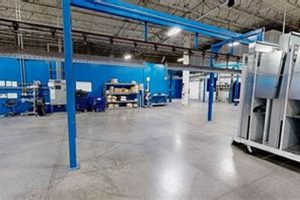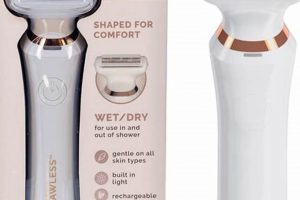This is a handheld instrument designed to refine and smooth the appearance of sealant after it has been applied. For example, after a bead of caulk is laid down along a bathtub edge, this instrument is used to create a clean, professional-looking seal, free of imperfections and excess material. This ensures a watertight barrier and an aesthetically pleasing result.
Proper finishing is crucial for several reasons. It not only enhances the visual appeal of the sealed joint but also contributes significantly to the longevity and effectiveness of the sealant. A smooth, well-defined surface is less prone to trapping dirt and moisture, thereby preventing the growth of mold and mildew. Historically, individuals used makeshift items like fingers or spoons; specialized implements offer improved precision and consistency.
The subsequent sections will delve into the various types available, techniques for effective usage, and maintenance practices to ensure optimal performance and extended service life of these tools.
Tips for Effective Sealant Application
Achieving professional-grade results with sealants requires careful attention to technique and the proper utilization of specialized implements. The following tips outline best practices for optimizing sealant application and achieving a consistently superior finish.
Tip 1: Select the Appropriate Size: Acquire a variety of sizes to accommodate different joint widths. Using an appropriately sized instrument prevents over- or under-application of pressure, resulting in a cleaner, more consistent bead.
Tip 2: Maintain a Consistent Angle: When drawing the instrument along the sealant bead, maintain a consistent angle. This ensures uniform material removal and prevents uneven surfaces.
Tip 3: Apply Even Pressure: Consistent pressure is crucial for achieving a smooth, uniform finish. Avoid applying excessive force, which can cause the sealant to squeeze out from the joint.
Tip 4: Clean the Instrument Regularly: Wipe the instrument clean after each pass. This prevents the accumulation of sealant on the edge, which can lead to imperfections and an uneven finish.
Tip 5: Lubricate the Instrument (If Necessary): For certain sealant types, a light lubricant, such as water or mineral spirits (depending on the sealant type), can help prevent sticking and improve glide. Test the lubricant on a small, inconspicuous area first to ensure compatibility.
Tip 6: Practice Proper Joint Preparation: Ensure the joint is clean, dry, and free of debris before applying sealant. This promotes optimal adhesion and prevents the formation of voids or bubbles.
Tip 7: Work in Sections: Apply sealant in manageable sections, allowing for timely finishing. This prevents the sealant from drying too quickly, which can make it difficult to achieve a smooth finish.
By adhering to these techniques, individuals can significantly improve the quality and longevity of their sealant applications. The resulting seals will be both aesthetically pleasing and highly effective in preventing moisture intrusion and air leakage.
The subsequent sections will provide guidance on selecting the optimal type of tool for specific applications and maintaining these implements for long-term performance.
1. Shape
The form of a sealant finishing instrument directly dictates its suitability for specific applications and the quality of the resulting sealant bead. Variations in shape address diverse joint geometries and sealant types, allowing for precise control and a professional finish.
- Rounded Edge
Rounded edges are commonly employed for creating concave sealant profiles, often seen in bathtub or shower installations. The curvature allows for smooth material removal and the formation of a clean, watertight seal, minimizing the risk of water pooling and subsequent mold growth.
- Sharp Corner
Tools featuring sharp corners are advantageous for applications requiring precise edges, such as where sealant abuts tile or other flat surfaces. The defined edge allows for clean separation and prevents sealant from overlapping onto adjacent materials, contributing to a visually appealing and professional result.
- Angled Profile
An angled profile facilitates access to tight corners and recessed areas. This design enables the user to effectively smooth and shape sealant in areas that would be difficult to reach with a standard flat-edged implement, ensuring consistent coverage and a uniform finish in challenging locations.
- Multi-Shape Designs
Certain finishing instruments incorporate multiple shapes on a single tool. This versatility allows the user to adapt to varying joint profiles and sealant consistencies without switching between implements, streamlining the application process and improving efficiency.
The selection of an appropriate shape, therefore, depends critically on the specific application and the desired aesthetic. A nuanced understanding of these form factors enables the user to achieve a professional and durable sealant application, irrespective of joint complexity.
2. Material
The composition of a sealant finishing instrument is intrinsically linked to its performance, longevity, and ease of use. The material selection dictates its resistance to sealant adhesion, cleanability, and overall durability, directly impacting the quality of the finished sealant bead.
- Plastic Polymers
Plastic polymers, such as polypropylene or nylon, are commonly employed due to their affordability and non-stick properties. These materials resist sealant adhesion, facilitating easy cleaning. However, plastic may exhibit lower durability compared to other materials, potentially leading to wear or breakage under heavy use. Examples include basic finishing tools often bundled with sealant cartridges. Their implications involve a balance between cost-effectiveness and longevity.
- Stainless Steel
Stainless steel offers superior durability and resistance to corrosion. This material is less prone to damage from solvents or abrasive cleaning agents, ensuring a longer service life. While sealant may adhere more readily to stainless steel compared to plastic, proper cleaning protocols can mitigate this issue. High-quality, professional-grade tools often utilize stainless steel construction. The increased durability translates to a reliable, long-lasting implement for frequent use.
- Rubber or Silicone Overmolds
Some finishing instruments incorporate rubber or silicone overmolds on the handle to enhance grip and comfort. These materials provide a non-slip surface, even when wet, improving control and reducing hand fatigue during extended use. The overmolds do not directly contact the sealant but contribute to the user’s ability to apply consistent pressure and achieve a smooth finish. These are found on higher-end tools prioritizing ergonomics.
- Composite Materials
Advanced composite materials offer a balance between durability, weight, and non-stick properties. These materials may incorporate fillers or coatings that further enhance sealant resistance and cleanability. Tools constructed from composites represent a premium option, providing exceptional performance and longevity. Their integration suggests a continued focus on material science to optimize the functionality of sealant finishing implements.
The optimal material selection depends on the frequency of use, the types of sealants employed, and the desired level of durability. Understanding the characteristics of each material allows professionals and DIY enthusiasts alike to choose the most appropriate implement for their specific needs, ultimately contributing to a superior sealant application.
3. Size
The dimension of a sealant finishing implement is a critical parameter affecting its efficacy and adaptability across various joint configurations. Selecting the appropriate dimension ensures optimal contact, consistent pressure distribution, and a professional sealant finish.
- Joint Width Correspondence
The instrument’s dimension should closely align with the width of the sealant joint. A tool that is too large will spread sealant beyond the intended area, creating a messy and unprofessional appearance. Conversely, an implement that is too small will not adequately smooth and shape the sealant, resulting in an uneven and potentially compromised seal. Consider a narrow bead of caulk along a window frame versus a wide expansion joint in concrete; each necessitates a different instrument dimension for optimal results. Proper dimensioning directly impacts the seal’s integrity and aesthetics.
- Surface Area Contact
The surface area in contact with the sealant influences the amount of pressure distributed during finishing. A larger surface area distributes pressure more evenly, reducing the risk of gouges or unevenness. A smaller surface area concentrates pressure, allowing for more precise shaping in intricate areas. Consider the finishing of a small, decorative tile joint versus a large, utilitarian expansion joint. The surface area must be appropriate to the application to achieve consistent and controlled results.
- Accessibility in Confined Spaces
Smaller dimensions are often necessary when working in confined or difficult-to-reach areas. Larger tools may be unwieldy and prevent proper access to the joint, leading to a compromised finish. For instance, finishing sealant around closely spaced plumbing fixtures requires a smaller, more maneuverable instrument. Dimension therefore directly influences accessibility and the ability to achieve a professional finish in challenging environments.
- User Comfort and Control
The overall dimension affects user comfort and control. A tool that is too large may be difficult to grip and maneuver, leading to fatigue and reduced precision. A tool that is too small may feel unstable and require excessive force. Ergonomic considerations dictate that the dimension should be appropriate for the user’s hand size and the complexity of the task. Properly sized tools contribute to reduced strain and improved control, resulting in a higher quality finish.
In summary, dimension is a crucial factor when selecting sealant finishing instruments. Precise alignment with joint width, appropriate surface area contact, accessibility in confined spaces, and user comfort all contribute to achieving a professional and durable sealant finish. A careful consideration of dimension optimizes both performance and user experience.
4. Durability
The longevity of a sealant finishing instrument, quantified as its durability, directly influences its cost-effectiveness and the consistency of sealant application results over time. A tool constructed from robust materials and exhibiting resistance to wear maintains its original shape and functionality, ensuring consistent performance across multiple projects. For example, a stainless-steel implement will withstand repeated use and cleaning cycles far better than a plastic counterpart, preventing deformation or degradation that could compromise the smoothness of the finished sealant bead. This characteristic is particularly crucial for professionals who rely on these tools daily, where frequent replacement due to wear represents a significant expense and potential disruption.
Material selection constitutes a primary determinant of durability. As previously discussed, stainless steel and composite materials offer superior resistance to physical damage and chemical degradation compared to polymers. Furthermore, the manufacturing process influences the overall resilience of the implement. For instance, a tool featuring a seamless construction will be less prone to breakage at joints or seams. Consider a scenario where a contractor is sealing multiple bathrooms in a large building; a durable tool will withstand the rigors of continuous use, maintaining its shape and effectiveness, whereas a less durable tool may require frequent replacement, leading to project delays and increased material costs.
Ultimately, durability represents a key performance indicator for sealant finishing instruments. It minimizes long-term expenses, ensures consistent results across multiple applications, and reduces the environmental impact associated with frequent tool replacement. Understanding the factors that contribute to durability empowers informed purchasing decisions and promotes the responsible utilization of these implements, aligning with both economic and sustainability objectives.
5. Maintenance
The sustained performance and longevity of a sealant finishing instrument are inextricably linked to diligent maintenance practices. Neglecting proper upkeep diminishes the tool’s effectiveness, compromises the quality of the sealant application, and ultimately reduces its lifespan. Regular cleaning, appropriate storage, and periodic inspection are essential for preserving the instrument’s functionality and ensuring consistent results.
- Immediate Post-Use Cleaning
The prompt removal of sealant residue following each application prevents hardening and buildup, which can compromise the tool’s shape and functionality. The appropriate cleaning agent, selected based on the sealant type (e.g., mineral spirits for silicone-based sealants, water for latex-based sealants), should be used to thoroughly clean all surfaces. Residual sealant can impede smooth operation and negatively impact the subsequent application. Consider the scenario of a professional applicator using multiple sealant types; consistent and immediate cleaning is paramount to prevent cross-contamination and ensure optimal performance across various materials. The implications of neglecting this step range from reduced precision to complete tool failure.
- Appropriate Storage Practices
Proper storage protects the instrument from physical damage and environmental degradation. Storing tools in a designated container or toolbox prevents accidental bending, scratching, or chipping, which can alter their shape and compromise their ability to create a smooth, uniform finish. Exposure to extreme temperatures or direct sunlight can also degrade certain materials, such as plastic polymers. Consider the storage environment in a humid climate; moisture can promote corrosion on metallic components, necessitating the use of rust-preventative measures. The practice of appropriate storage extends the functional life of the instrument and preserves its performance characteristics.
- Periodic Inspection and Sharpening (If Applicable)
Regular inspection for wear, damage, or deformities is crucial for identifying potential issues before they compromise the sealant application. Nicks or imperfections on the finishing edge can create uneven sealant beads and detract from the overall appearance. For tools with replaceable blades or sharpened edges, periodic maintenance ensures optimal performance. Consider the scenario of an applicator noticing a burr on the edge of the tool; prompt removal of the burr is essential to prevent it from creating imperfections in the sealant. This proactive approach to maintenance preserves the instrument’s precision and ensures consistently high-quality results.
- Material-Specific Maintenance Protocols
The maintenance regimen should be tailored to the material composition of the sealant finishing instrument. As previously discussed, stainless steel requires different cleaning agents than plastic polymers. Abrasive cleaners can damage certain materials, while solvent-based cleaners may degrade others. Adhering to manufacturer-recommended cleaning and maintenance protocols ensures the longevity and optimal performance of the instrument. Consider the use of an inappropriate cleaning agent on a plastic tool; the resulting damage could render the tool unusable and necessitate replacement. Material-specific maintenance protocols minimize the risk of damage and maximize the tool’s lifespan.
In summary, diligent maintenance practices are essential for preserving the performance and extending the lifespan of sealant finishing instruments. Regular cleaning, appropriate storage, periodic inspection, and material-specific maintenance protocols contribute to consistent sealant application results and minimize long-term costs associated with tool replacement. Embracing a proactive approach to maintenance optimizes both the functionality and the economic value of these implements.
Frequently Asked Questions
This section addresses common inquiries regarding these instruments, providing concise and authoritative answers to enhance understanding and promote proper utilization.
Question 1: What constitutes the primary function of a sealant finishing implement?
The fundamental purpose is to refine and smooth the sealant bead immediately after application. This process ensures a uniform surface, enhances adhesion, and improves the overall aesthetic appearance of the sealed joint.
Question 2: How does the shape of the instrument influence the sealant finish?
Different shapes cater to specific joint geometries and sealant types. Rounded edges are suitable for concave profiles, while sharp corners are effective for creating defined edges along adjacent surfaces. Selection should align with the desired aesthetic and functional requirements.
Question 3: What materials are commonly used in their construction, and how do these materials affect performance?
Common materials include plastic polymers, stainless steel, and composite materials. Stainless steel offers superior durability and solvent resistance, while plastics provide non-stick properties and cost-effectiveness. Composite materials offer a balance of these characteristics. The material selection directly influences the instrument’s lifespan and ease of cleaning.
Question 4: Is there a specific technique to maintain a sealant finishing instrument?
Regular cleaning following each use is crucial to prevent sealant buildup. The appropriate cleaning agent should be selected based on the sealant type and the instrument’s material. Proper storage in a dry, protected environment prevents physical damage and material degradation.
Question 5: Does the dimension of the tool affect the outcome of the sealant application?
Yes, the instrument’s dimension should correspond to the width of the sealant joint. An appropriately sized tool ensures optimal contact, consistent pressure distribution, and a professional finish. Undersized or oversized implements can compromise the integrity and appearance of the seal.
Question 6: How frequently should these tools be replaced?
The replacement frequency depends on the material composition, frequency of use, and maintenance practices. Durable materials, such as stainless steel, can withstand extended use with proper care. Signs of wear, damage, or deformation indicate the need for replacement to ensure consistent performance.
In summary, the proper selection, utilization, and maintenance of sealant finishing instruments are essential for achieving professional-grade results. Adherence to these principles ensures consistent sealant application, enhances longevity, and optimizes overall performance.
The subsequent section will explore advanced techniques and emerging trends in sealant application technology.
Conclusion
This exploration has elucidated the pivotal role of the caulking finish tool in achieving professional-grade sealant applications. Key considerations include material composition, shape, dimension, durability, and maintenance practices. A thorough understanding of these factors empowers informed selection and utilization, ensuring optimal results across diverse applications.
The proper application and maintenance of this specific instrument not only enhances aesthetic outcomes but also contributes significantly to the longevity and efficacy of sealant joints. Continued adherence to established best practices remains paramount for maintaining structural integrity and preventing moisture intrusion. Further advancements in material science and ergonomic design promise to further refine the capabilities of these critical implements in the future.




![Status Check: Is Ragna Crimson Manga Finished [Spoiler Alert!] Best Final Touch: Elevate Your Projects with Professional Finishing Status Check: Is Ragna Crimson Manga Finished [Spoiler Alert!] | Best Final Touch: Elevate Your Projects with Professional Finishing](https://bestfinaltouch.com/wp-content/uploads/2025/12/th-666-300x200.jpg)


